Karangasem in East Bali was once a powerful kingdom with captivating landscapes, fascinating history, boisterous traditional markets, and grand palaces. Today, a visit to the regency allows travellers to step back in time as they wander through the beautiful, manicured gardens of Karangasem water palaces.
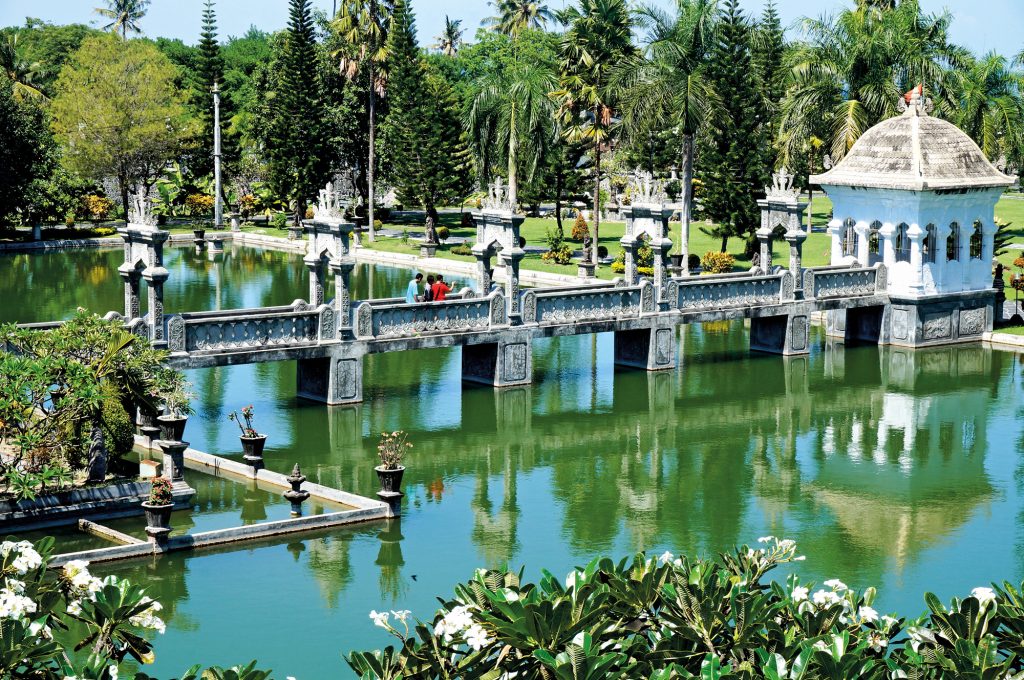
If the walls at these Bali palaces could talk, they would have plenty to say.
The Balinese kingship spanned from early 10th to early 20th century, with Karangasem being one of the nine kingdoms. These kingdoms were known to have flourished, enriched, and shaped the island’s culture through establishing the sophisticated Balinese court culture that combines the Hindu influences with Bali’s own native spiritual elements and ancient reverence.
Kings then built their palaces that acted as the centres of power, a place where they initiated and preserved laws, and held rituals in which their subjects could be involved. In East Bali, the last King of Karangasem in the late 20th century built Taman Ujung and Tirta Gangga to add to his Puri Agung Karangasem Royal Palace. At present, both Taman Ujung and Tirta are some of Bali’s major attractions, inviting visitors to Bali to be enthralled especially by the water features of the two royal sites that make up the quieter eastern side of Bali.
A PICTURESQUE KILLING FIELD
The spectacular coastal road of eastern Bali is an adventure in its own right, with green hills on one side and stunning cliffs and raw ocean views on the other. Many of the villages don’t really receive a large number of visitors, thus ideal for those who wish to avoid tourist crowds.
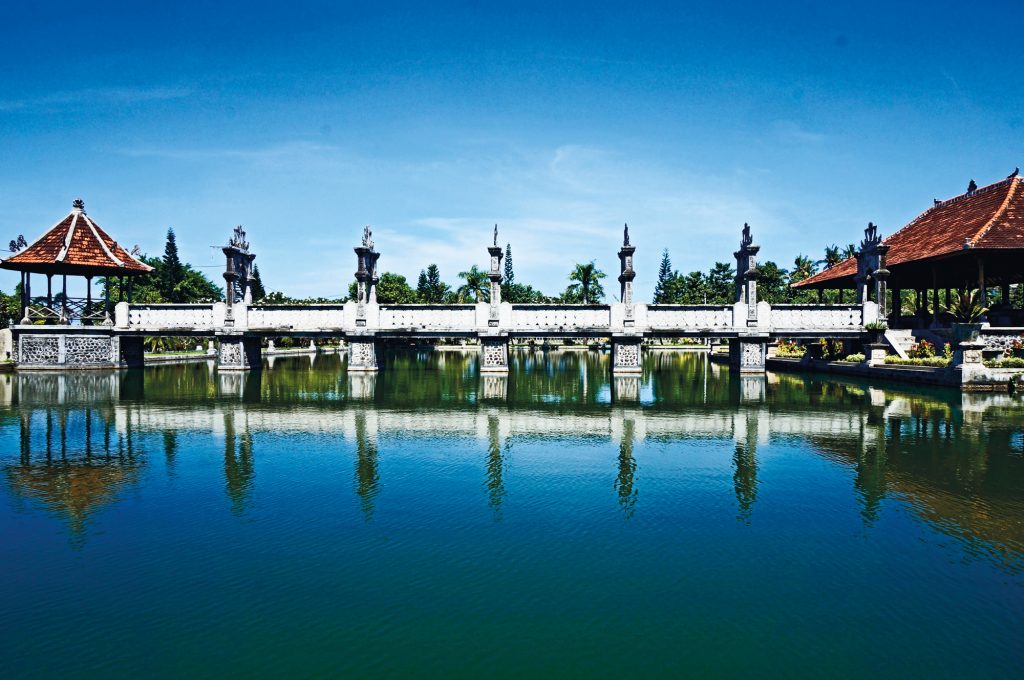
Leaving Amlapura and into Tumbu village, where the charming Karangasem countryside takes over the view, you will find this royal retreat constructed by the late King of Karangasem, I Gusti Bagus Djelantik that reigned from 1909 until 1945. It was built to welcome and serve visiting dignitaries and kings from neighbouring countries, besides for the pleasure of the king and his royal family.
Loosely translated to “the garden on the far end”, Taman Ujung is unique with old omissions and beautiful fish ponds that surround its premises, while keeping the high value history of the empire of Karangasem in East Bali.
Standing on the main round pavilion of Taman Ujung will give you the best panoramic views of Lombok Strait, the silhouette of Mount Lempuyang, and the serene views of the surrounding area. Yet, as visually stunning and tranquil as it is at present, the reputation of the beautifully landscaped water garden was anything but. The villagers who lived in this area during the eleventh century when this royal compound was active, lived constantly in absolute dread of this property, which they considered to be haunted by the tortured souls of the countless people who died here. On one dark day in the eleventh century, the then King of Karangasem heard that there was an increasingly popular local movement utilising magic spells to diminish his royal authority and end his royal life. So, he decided to hold a wholesale purge and ordered his soldiers to arrest all those suspected of practicing black magic.
The soldiers marched from village to village rounding up almost the entire village’s population, sparing nary a soul. When the troops had gathered all the people that their numbers could control, they about-faced and marched their detainees before the waiting king. Having delivered their charges, the soldiers marched out again to round up more allegedly evil villagers. Thousands of villagers huddled together in the centre of this field waiting to be judged by their king. They didn’t stand a chance.
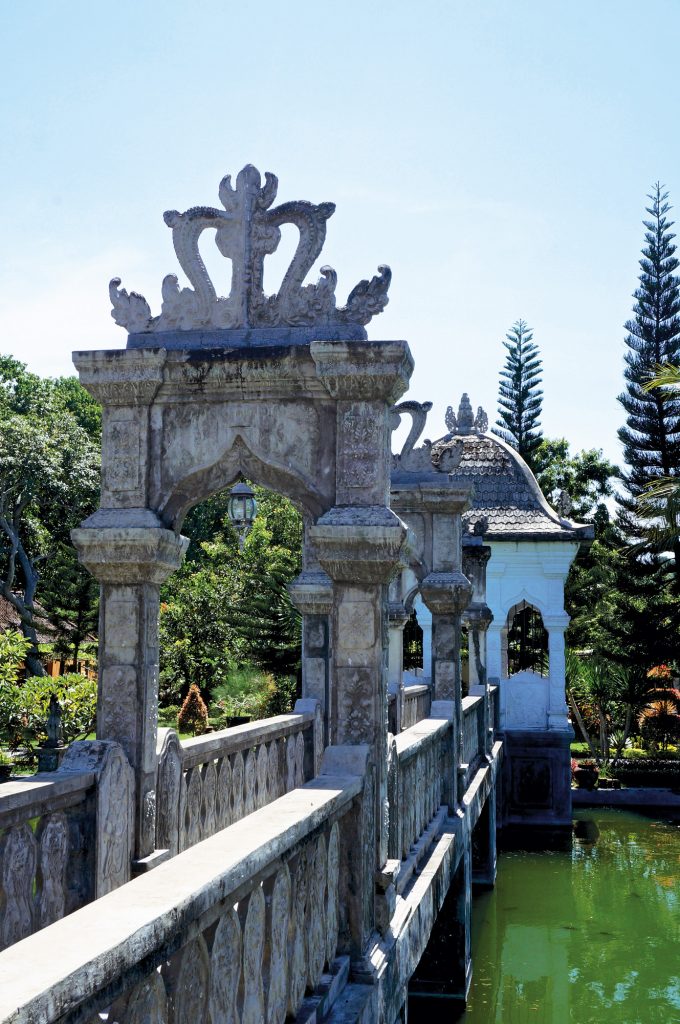
The horrible reputation and fear of this location continued for many years in the hearts of many Balinese, who have a natural tendency for superstition. For some Balinese people, even by day this place has a heavy pall over it; a sadness that is physically tangible and that can impact those sensitive to such an ‘aura’. For these people, to visit this beautiful property at night is absolutely unthinkable.
Despite the rumours saying that the place is haunted, more and more tourists (domestic and international) are coming to Taman Ujung. The main object of this royal property is the pools with the surrounding buildings. The architecture is a blend of several cultures: a western style was implemented for the gazebo, the arches are Middle Eastern, and the plentiful detailed carvings are Balinese. The young generation of the Balinese living in the surrounding area doesn’t seem to be affected by the massacre tale; they use Taman Ujung as a place to have a relaxing walk and jog before sunset time.
A ROYAL BATHING HOUSE
A place where history meets relaxation, and architecture meets nature; Tirta Gangga is one of the most distinct and most recognisable places in Bali. Stepping in to the water palace complex, the atmosphere of authentic royal magnificence will immediately become evident for every visitor. The one-hectare property located on the outskirt of Amlapura in its well-known current state, was built in 1948 by the last king of Karangasem.
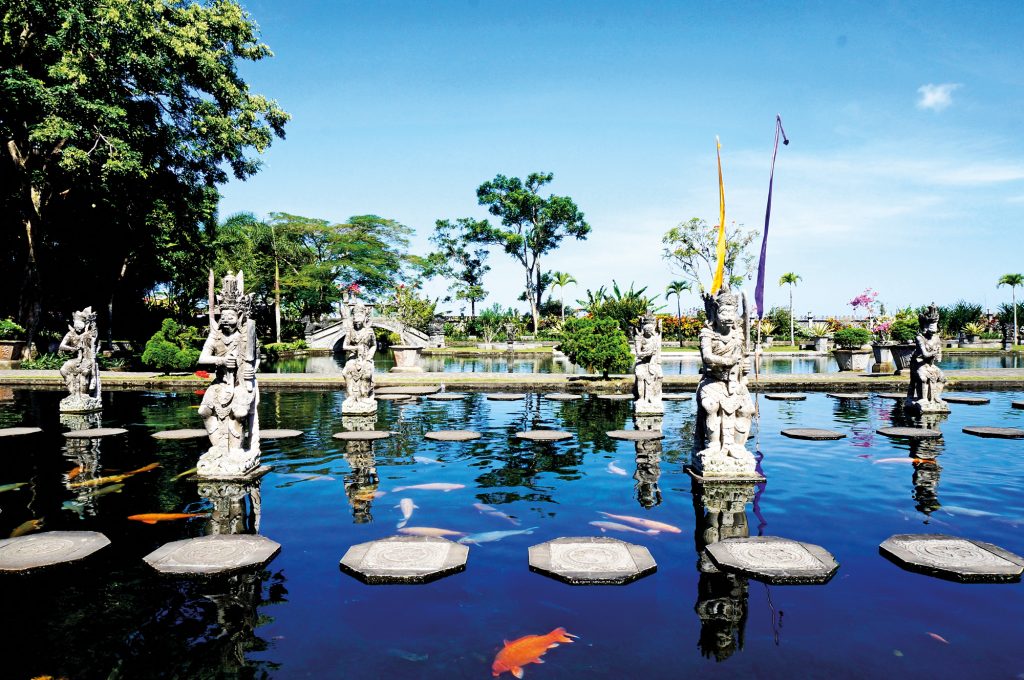
Being a posh noble, who was also a proponent of beautiful architecture and an art patron, the king himself was the architect of the water palace who worked in the mud together with his labourers, digging out the pools and ponds. Today, the water palace’s maze of pools and fountains surrounded by a lush garden and stone carvings and statues is one of the most photographed places of interest on the island.
The water palace, meaning “water of the Ganges”, displays a unique mix of Balinese and Chinese architecture as portrayed in the palace’s centrepiece, an eleven-tiered fountain. It has been rebuilt and restored after the property was almost entirely destroyed by the eruption of Mount Agung in 1963.
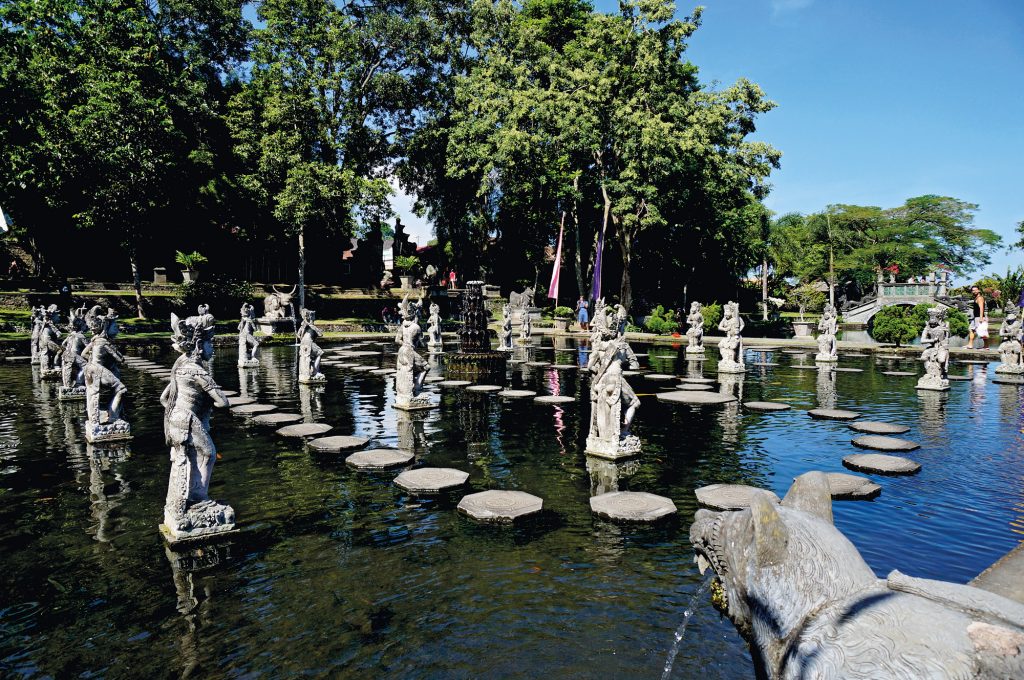
Comprised of three separate areas, this royal bathing-cum-relaxing complex now allows every visitor to get a taste of the life of Balinese royals. On the first level of the water palace, the part of the property that is probably most photographed, you can find two large fish ponds with tens of Balinese statues and beautifully positioned stepping stones for everyone to wander through the pools. The second is where two spring water swimming pools are located. You can access the swimming pools and take a dip (and swim!). On the third level you can find a restaurant and bungalow units (available for rent); this area used to be the part of the water palace where the king built his country home, affording breathtaking views of the palace’s water features below and the lush surrounding.
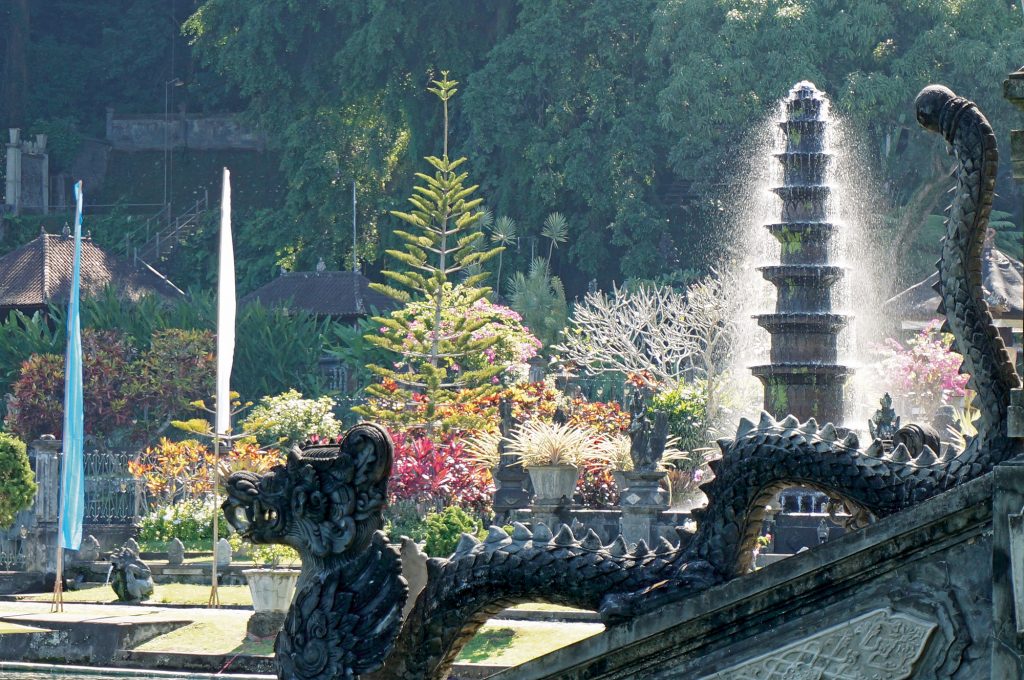
A reservoir on the grounds of the complex receives the spring water and from this reservoir drinking water is delivered via a pipe system to Amlapura. There is also an underground pipe system which leads to the upper swimming pool, where it emerges through the mouth of a raksasa (a demon statue) which stands at a corner of the pool. Here the water flows over into a lower level pool. From this lower level pool it flows into some small fish ponds and from there into the rice fields that border the gardens.
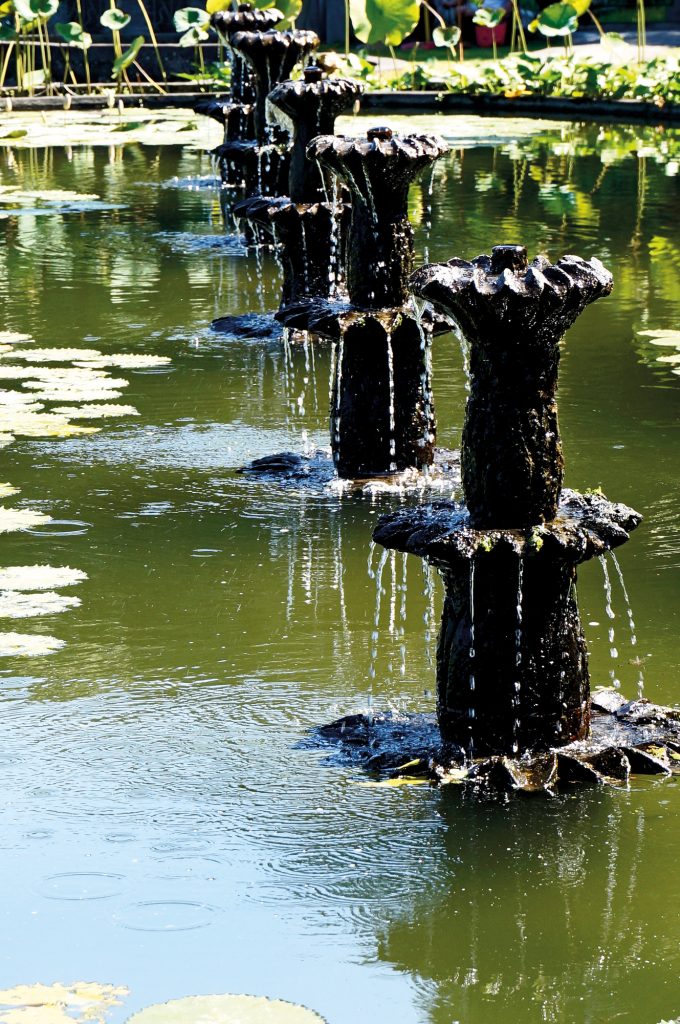
The water of Tirta Gangga has always been regarded as holy and is regularly used for religious temple ceremonies. During important celebration days Tirta Gangga is the destination of colourful processions with offerings, umbrellas, flags and other tributes. Led by the local temple priests, ceremonies are held at the spring, accompanied by chanting and the music of the ‘Beleganjur’, a gamelan group of small gongs with each musician striking a specific, different note on the musical scale, all blending in harmony.







